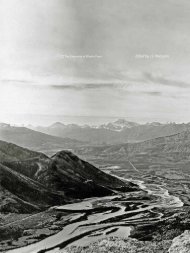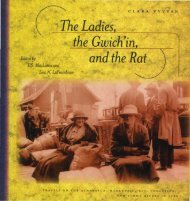Paul Kane's Journal of his Western Travels, 1846-1848 - History and ...
Paul Kane's Journal of his Western Travels, 1846-1848 - History and ...
Paul Kane's Journal of his Western Travels, 1846-1848 - History and ...
You also want an ePaper? Increase the reach of your titles
YUMPU automatically turns print PDFs into web optimized ePapers that Google loves.
George Simpson to open a trail from Edmonton to the Athabasca<br />
River (see Frot Asneboin), the vital supply link in the transcontinental<br />
trade route from the Colwnbia River, New Caledonia,<br />
<strong>and</strong> 1bompson River districts on the Pacific Slope.<br />
One <strong>of</strong> the most important chief factors in the HBC, Row<strong>and</strong><br />
built Fort Edmonton into one <strong>of</strong> the most pr<strong>of</strong>itable <strong>and</strong> physically<br />
imposing posts in the empire. His success lay partly in <strong>his</strong><br />
ability to negotiate among the various opposing tribes <strong>of</strong> Plains<br />
Indians; the Blackfoot Confederacy warred with the Cree <strong>and</strong><br />
Assiniboine for the territory in which the North Saskatchewan<br />
River lay. TIley all came to find Row<strong>and</strong> a brave, fair man,<br />
calling him "Iron Shirt" <strong>and</strong> "Big Mountain," t<strong>his</strong> despite the<br />
fact that he was short <strong>and</strong> quite lame. [fhe exhibited a shortcoming,<br />
it was <strong>his</strong> disinclination to support wholeheartedly the<br />
efforts <strong>of</strong> the missionaries on the prairies. In <strong>his</strong> '"Character<br />
Book, " Governor Simpson reserved <strong>his</strong> highest praise for Row<strong>and</strong>:<br />
"One <strong>of</strong> the most pushing bustling Men in the Service<br />
whose zeal <strong>and</strong> ambition in the discharge <strong>of</strong> <strong>his</strong> duty is unequalled.<br />
. . . Of a fiery disposition <strong>and</strong> as bold as a Uon. An<br />
excellent Trader who has the peculiar talent <strong>of</strong> attracting the<br />
fiercest Indians to him while he rules them with a Rod <strong>of</strong> Iron <strong>and</strong><br />
so daring that he beards their Chiefs in the open camp while<br />
surrounded by their Warriors .... full <strong>of</strong> drollery <strong>and</strong> hwnour<br />
<strong>and</strong> generally liked <strong>and</strong> respected by Indians Servants <strong>and</strong> <strong>his</strong><br />
own equals" (182-183).<br />
Rvw<strong>and</strong> was returning to Fort Edmonton from Yom Factory<br />
in August, <strong>1846</strong>, when Kane joined <strong>his</strong> annual Saskatchewan<br />
brigade at Norway House. The Chief Factor was on furlough in<br />
Montreal in 1847-<strong>1848</strong>, when Kane spent Christmas at Fort<br />
Edmonton. In 1854, although he had decided to retire, he died in<br />
the course <strong>of</strong> duty , apparently <strong>of</strong> a stroke, while en route to Fort<br />
Pitt.<br />
Rown, Mr. J. John Row<strong>and</strong> Jr., the one son <strong>of</strong> Row<strong>and</strong> Sr. to<br />
join the fur trade, was the trader at Fort Pitt. He came to<br />
Edmonton at Christmas, 1847, <strong>and</strong> on January 6, <strong>1848</strong>, he<br />
married Margaret (see Prudence, Mr.), daughter <strong>of</strong> John Edward<br />
Harriott (see Harltt/Harett/H., Mr.), who was superintending<br />
Fort Edmonton during the furlough <strong>of</strong> Row<strong>and</strong> Sr.<br />
S<strong>and</strong>witch Isl<strong>and</strong>ers The Pacific Slope districts <strong>of</strong> the fur trade<br />
had long employed native Hawaiians, much as the eastern <strong>and</strong><br />
northern districts had employed Orcadians (see Orkey /orknie).<br />
Wilson Price Hunt, an Astorian (see Astoria), had begun the<br />
practice on the Colwnbia River as soon as Astoria was built in<br />
1811. Nonnally, the Hawaiians proved to be reliable employees,<br />
with especially well developed skills on the water. John Mc<br />
Loughlin, Chief Factor at Fort Vancouver from 1824 to <strong>1846</strong>,<br />
named Owyhee River, in southeastern Oregon, in recognition <strong>of</strong><br />
the part played by Hawaiians in the fur trade.<br />
Sanschay See Lefrombeys.<br />
Saskatchawan The Saskatchewan River is the principal river<br />
system north <strong>of</strong> the Missouri, draining much <strong>of</strong> the Canadian<br />
prairies from the Rocky Mountains to Hudson Bay. Its name<br />
derives from the Algonquian words, KisiskaJchewani Sipi. for<br />
"swift-ftowing river." At its eastern extent, Cedar Lake (see<br />
seder Lake) <strong>and</strong> Gr<strong>and</strong> Rapid (see gr<strong>and</strong> Rapid/gr<strong>and</strong><br />
raped), where it enters Lake Winnipeg, the Saskatchewan is<br />
unified. Upriver 375 miles (west) are the forks <strong>of</strong> the North <strong>and</strong><br />
South Saskatchewan, which drain very different l<strong>and</strong>. Taking its<br />
rise in the Columbia Icefield (<strong>and</strong> for that reason, never used as a<br />
route across the mountains), the North Saskatchewan remains<br />
84<br />
entirely within the prairie parlc1<strong>and</strong>, while the South Saskatchewan,<br />
which is fed by the Bow <strong>and</strong> Oldman rivers, drains<br />
grassl<strong>and</strong>s. T<strong>his</strong> distinction is crucial for the underst<strong>and</strong>ing <strong>of</strong> the<br />
paramount significance to the fur trade <strong>of</strong> the North, <strong>and</strong> the<br />
comparative insignificance <strong>of</strong> the South Saskatchewan: the<br />
beaver thrives only where trees do. As well, because the South<br />
Saskatchewan lay, in the time <strong>of</strong> <strong>Kane's</strong> travels, within the<br />
territory controlled by the bellicose Blackfoot Confederacy,<br />
travel along it was hazardous. Nevertheless, the fur trade relied<br />
on bison for its supply <strong>of</strong> pemmican, with which brigades could<br />
sharply reduce the time taken from travel for hunting, thereby<br />
making possible communication from the more remote Athabasca<br />
River, Mackenzie River, <strong>and</strong> New Caledonia districts to<br />
Hudson Bay <strong>and</strong> back in a single season's travel. Thus, st>rne<br />
auxiliaIy use <strong>of</strong> the South Saskatchewan district was necessarily<br />
made.<br />
Saot de S~ Marey /sault/Sault Sault Sainte Marie (est. 1668)<br />
was visited by Kane July, 1845, May 19, <strong>1846</strong>, <strong>and</strong> October 1,<br />
<strong>1848</strong>. Established as a mission in 1668 by Pere Marquette, a<br />
post at the rapids <strong>of</strong> the Saint Marys River, between lakes<br />
Superior <strong>and</strong> Huron, was maintained from that point on.<br />
seder Lake On the transcontinental fur trade route, the first lake<br />
that lay west <strong>of</strong> Lake Winnipeg, Cedar Lake was reached by a<br />
portage around Gr<strong>and</strong> Rapid (see gr<strong>and</strong> Rapid/gr<strong>and</strong> raped).<br />
[t is a widening <strong>of</strong> the Saskatchewan River, having The Pas to its<br />
irrunediate west.<br />
Setter, Mr. George Setter (c. 1782-1868), named "Seder" in<br />
WA (47, 48), joined the HBC as a laborer in 1805. He retired in<br />
1858, <strong>and</strong> died at the Red River Settlement. Setter spent most <strong>of</strong><br />
<strong>his</strong> very long career in the Red River district, <strong>and</strong> had been the<br />
postmaster at Fort Alex<strong>and</strong>er for one year when Kane met him in<br />
JWle, <strong>1846</strong>. An Orcadian (or Oricneyman, as the HBC referred<br />
to a native from the Orkney Isl<strong>and</strong>s), Setter proved a faithful<br />
employee; according to Governor Simpson's' 'Character Book"<br />
(235), however, an acci~nt that rendered Setter lame precluded<br />
<strong>his</strong> assuming the comm<strong>and</strong> <strong>of</strong> any important post.<br />
Sew/Sews/Sewes Sioux are Dakota whose territory in the 1840s<br />
included the drainage basins <strong>of</strong> the Red, Rainy, <strong>and</strong> upper<br />
Mississippi rivers, as well as the Qu'appelle, Platte, <strong>and</strong> even<br />
Yellowstone river valleys. In the vicinity <strong>of</strong> Red River, where<br />
Kane encountered them, the Sioux' enemies were the Saulteaux<br />
<strong>and</strong>, because they competed with them for bison when the<br />
numbers <strong>of</strong> that animal were quickly dwindling, the Metis.<br />
Shew shwopp/Sbew~hops The Shuswap are the northernmost<br />
<strong>of</strong> the four native groups occupying the interior plateau <strong>of</strong><br />
present~y southern British Columbia. 1beir territory was once<br />
vast, <strong>and</strong> is still large. Villages on the North <strong>and</strong> South Tho~<br />
son rivers <strong>and</strong> around the Shuswap Lakes are the most prominent<br />
"'"<br />
settlements; these areas lie to the west <strong>of</strong> the site <strong>of</strong> Boat<br />
Encampment, across the Monashee Mountains.<br />
Shutes/Shoots See La Shute/Shu~/Sboots.<br />
Silver falls/Silver faD<br />
fall.<br />
See fall <strong>of</strong> the Pransin Horses or silver<br />
Sirmon, Sir George/Sir Gorge/Sir G./Sur G. Sir George<br />
Simpson (1787 -1860; lent. 1841) entered the employ <strong>of</strong> the<br />
HBC as its Governor-in-Olief in 1820. He helped to effect the<br />
merger <strong>of</strong> the HBC <strong>and</strong> North West Company in 1821, <strong>and</strong> for<br />
Guide
















